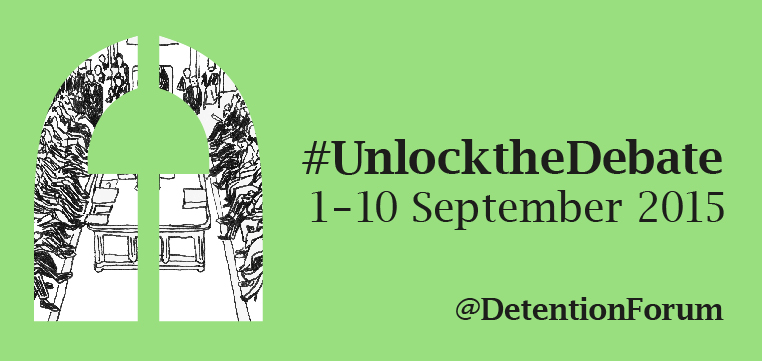3 September 2015
As part of #UnlocktheDebate, the Detention Forum members will be sharing their views ahead of the parliamentary debate on the detention inquiry recommendations on 10th Sep 2015.
In this piece, Jerome Phelps of Detention Action examines the Government’s repeated claim that ‘there is no such thing as indefinite detention and hence there is no need for a time limit on immigration detention’. Introducing a 28-day time limit on immigration detention was one of the key recommendations of the detention inquiry report.
Tweet your feedback to us (@DetentionForum) or with a hashtag, #UnlockTheDebate. Detention Action tweets at @DetentionAction
========================================================================
Next week, the UK’s practice of indefinite immigration detention will come under renewed scrutiny, as Parliament debates the report of the cross-party parliamentary inquiry. The inquiry concluded that a time limit of 28 days should be introduced. The government is likely to respond that a time limit is unnecessary, and that the UK does not practice indefinite detention.
The UK is unique in Europe in detaining migrants without time limit, often for periods of years, with no indication of when they will be released. Yet the government refuses to accept that this amounts to indefinite detention.
When called on as part of the United Nations Universal Periodic Review process to take steps to avoid cases of indefinite detention, the UK felt able to partially accept the recommendation, on the basis that indefinite detention doesn’t happen anyway:
‘Although there is no fixed time limit on immigration detention under UK law or policy it operates in line with the established principle that it must not be unduly prolonged and must last for no longer than is reasonably necessary for the purpose for which it was authorised.’
This ‘established principle’ refers to the common law principles known as Hardial Singh. These principles date back to 1983, and one of the first legal challenges to immigration detention. They set out the conditions that the Secretary of State (the Home Secretary) must meet in order lawfully to detain a migrant. The principles were subsequently summarised as:
(i) The Secretary of State must intend to deport the person and can only use the power to detain for that purpose;
(ii) The deportee may only be detained for a period that is reasonable in all the circumstances;
(iii) If, before the expiry of the reasonable period, it becomes apparent that the Secretary of State will not be able to effect deportation within a reasonable period, he should not seek to exercise the power of detention;
(iv) The Secretary of State should act with reasonable diligence and expedition to effect removal.
The Hardial Singh principles mean that the Home Office cannot simply lock up a migrant and throw away the key. Even if the person can lawfully be detained and the Home Office is doing everything that it can to deport them, there will come a point at which detention stops being lawful, either because detention is no longer ‘reasonable’, or because it will become unreasonable before the person is deported.
If migrants cannot lawfully be detained forever, is it therefore wrong to speak of indefinite detention?
The Cambridge English Dictionary defines ‘indefinite’ as ‘not exact, not clear or without clear limits.’ Lucid as the Hardial Singh principles may be, they can hardly be claimed to set exact or clear limits to detention.
Indeed, the abundant case law on unlawful detention, which has proliferated over the last six years in tandem with the expansion of long-term detention, is decidedly unhelpful in providing any practical guide as to when detention will become unlawful in any given case. Each case must be assessed on its own merits, and previous cases give little indication of how each new case will be decided.
In the early days, hopes were raised by a ruling that 30 months was ‘right at the outer limit of the period of detention which can be justified’ except in cases of serious offending. But subsequent case law undermined the suggestion that 30 months could be any sort of rule of thumb for unlawfulness in typical cases.
Indeed, the courts have become ever more reluctant to spell out clear or exact limits to detention. In the influential view of the Court of Appeal, it is not the case that:
‘in order to maintain detention the Secretary of State must be able to identify a finite time by which, or period within which, removal can reasonably be expected to be effected… There can, however, be a realistic prospect of removal without it being possible to specify or predict the date by which, or period within which, removal can reasonably be expected to occur and without any certainty that removal will occur at all.’
So not only is there no clear or exact time limit to detention, the Home Office does not even have to indicate when it expects removal to be possible, or have any certainty that it will ever be able to remove the person.
Indeed, it is not even clear that the Hardial Singh principles actually provide the legal limit to detention, since the Court of Appeal has also found that not every breach gives rise to a claim of false imprisonment. Detention can be not lawful with reference to Hardial Singh, but not unlawful either: a novel legal status that has been described by an influential barrister blogger as ‘legal-ish’.
The predictable result has been that migrants have been detained for periods that would be considered preposterous in any other European state, on the thinnest of pretexts. Shafiq-ur-Rehman, for example, was detained for 3 years and ten months, for much of which he was cooperating with removal, after serving a single prison sentence of seven months for using a false passport.
Immigration detention in the UK frequently lasts for years. Last month HM Inspector of Prisons reported finding nearly 40 people detained for over a year in a single detention centre, the Verne, and one detained for over five years. There is no time limit, and no-one in detention can receive even the haziest estimation of how long their detention would be lawful. There are legal limitations on the period of detention, but breaching them may not be unlawful.
If this is not indefinite detention, then we are in the world of Kafka.

